| The Selection of Clausula Sources for ThirteenthCentury Motets:
Some Practical Considerations and Aesthetic Implications
1 |
| 音楽エッセイのページへ戻る | 初期多声音楽 | St.マーシャル楽派へ |
| Leoninのページへ | ノートルダム楽派(conductus)のページへ |
ペロタン(Viderunt Omnes) |
| ペロタン(Alleluja Nativitas) | ペロタン Clausulaのページ | まうかめ堂さんのページへ |
| substitute clausulaのページへ | 中世音楽のページへ | 前のページへ |
| 次のページへ |
| In addressing questions of compositional
process, scholars of medieval polyphony have relatively little on which to
build. They cannot gain insight from reading explicit written testimonies
by medieval composers; nor can they look to evidence such as sketches,
drafts, or revisions for guidance. Instead, they can only study
theoretical accounts of how to compose good discant and examine the
surviving pieces themselves to increase their understanding of medieval
compositional
process. 作曲過程の問題に取り組むにあたって、中世ポリフォニーを専攻する学者は、相対的に少ない。彼らは、中世の作曲家による明示的に書かれた証言を読むことから洞察を得ることができない。さらにまた、スケッチ、草稿、ガイダンスのための改訂のようなものさえ、見ることができない。その代わりに、彼らは、良いディスカントを作る方法のための理論的な説明のみを研究し、そして、中世の作曲家鄭の理解を増すために、残された作品片を精査することだけができる。 Of all the surviving types of medieval music, the early Latin motet offers perhaps the best opportunity to explore aspects of compositional process, for the vast majority of early Latin motets were created in several observable stages. More than one hundred years have passed since Wilhelm Meyer's pathbreaking report that many early motets originated with the the addition of text to preexisting discant clausulae (Meyer 1898). While Meyer'S discovery prompted an intense effort to identify related motets and clausulae (Ludwig 1910; Gennrich 1957; van der Werf 1989), other elements of compositional process were largely overlooked. Norman Smith (1989) recognized this lacuna and drew attention to the process of converting clausulae into motets; in this paper, I shall focus on an earlier stage of compositional process―the process of selecting clausula models to convert into motets. In brief, I shall identify factors that may have attracted medieval "composers" to select certain types of clausula models for early Latin motets.2 I shall then consider the extent to which their criteria for selection apply to other segments of the thirteenth-century motet repertory. As I will show, the initial selection criteria not only reflected practical considerations, but also had long-range aesthetic implications for the stylistic development of the medieval motet. 中世の音楽の残されたすべての形式のうち、初期のラテン語モテットはおそらくは作曲過程の観点から精査する最もよい機会を提供することであろう。なぜなら、初期のラテン語モテットの幅広い量は、いくつかの観察点を作り出すからである。 Wilhelm Meyerのブレイクスルー的レポート、すなわち多くの初期のモテットはもともと存在していたディスカントクラウズラへの歌詞の付加に由来するという主張が発表された1898年から100年以上が経過した。Meyerの発見は関連したモテットやクラウズラを同定する激しい努力を促したが、作曲過程の他の要素は見逃されてきた。 Norman Smithは1989年に、こうした欠落を認め、そしてクラウズラをモテットに変換する過程に注目をした。この論文において、私は初期中世の作曲過程、モテットに変換するクラウズラモデルの選択過程に焦点を置くつもりである。 手短に言えば、私は、初期ラテン語モテットのためのクラウズラモデルの種類を選択して、中世の作曲家を引きつけた要素を特定しようと思うのである。私はこうした選択基準が13世紀のモテットレパートリーの他の部分にも適用させることを広く考えたいと思う。 私が示すように、最初の選択基準は実践的配慮だけでなくまた、中世のモテットの形式的発展に対する幅広い範囲の美的意味合いもまた持つのである。 The surviving sources of Notre Dame polyphony indicate that the composers of the earliest motets did not indiscriminately add texts to all of the approximately 950 passages of discant; instead, they focused their efforts on less than twelve percent of the available repertory.3 To investigate potential criteria for selection, I compared a "motet group" of fifty-five clausulae that were converted into motets with a "control group" of 103 clausulae that did not become motets.4 The purpose of this comparison was to look for possible stylistic differences between the two groups; if found, significant differences could shed light on the process of selecting clausulae to transform into motets. ノートルダムポリフォニーの残された作品は最初期のモテットの作曲者たちは、およそ950にも上るディスカントのすべてに無差別に歌詞をつけることはなかったことを示している。その代わり彼らは、利用可能なレパートリーのうちの12%以下の対象に焦点を当てていた。 こうした選択のための潜在的な基準を精査するために、私はモテットとはならなかった103のクラウズラの”コントロールグループ”とともに、モテットに転換された55の”モテットグループ”を比較した。こうした比較の目的は、二つのグループ間の形式的な違いを見つけ出すためである。もしもそれが見つかれば、モテットへの転換のためのクラウズラの選択過程に対して、重大な相違が脚光を浴びることになるかもしれない。 The motet group contains both discant passages from organum (DP) and separate clausulae (CL) that served as models for early Latin two voice motets collected in manuscripts F and/or W2. Some of the clausulae in the motet group were also turned into three-voice conductus-motets, and many of them provided the basis for French contrafacta and/or later thirteenth-century double motets. Clausulae that were originally converted into French motets were excluded from initial consideration because they seem to reflect different practical and aesthetic concerns. モテットグループはオルガヌムからのディスカントパッセージ(DP)と、(そこから)切り離されたクラウズラ(CL)の両者を含んでいる。クラウズラは、F写本あるいはW2写本に集められた初期の2声ラテン語モテットに対するモデルとなった。モテットグループのクラウズラのいくつかはまた、3声のconductus-motetとなり、それらの多くはフランス語contrafactaや13世紀後半の3声モテットにたいする基礎を築いた。いきなりフランス語モテットへconvertされていたクラウズラは、研究範囲からは取り除かれた。なぜならそれらは異なった実践、美的案件であると見込まれるからである。 The control group was selected from the first two series of two-voice clausulae in the fifth fascicle ofF (Nos. 1-288), which contain the most recent and stylistically sophisticated clausulae in the manuscript.5 Since sixty of these 288 clausulae served as motet sources, it appears that the first two series of clausulae were not only available to composers for conversion into motets, but also generally suitable for texting. The same claim cannot be made for clausulae 289-462, which tend to be earlier in origin, simpler in style, and quite short in length (Baltzer 1995: xliv). Only the very last of these 174 clausulae served as a motet source. コントロールグループは、F写本の第5冊子中の2声クラウズラの最初の2つのseriesより選択された。これらは写本中でもっとも新しく様式的にも洗練されたクラウズラである。これらの288のクラウズラのうち60はモテットのソースとなっていたが、最初の2つのseriesのクラウズラはモテットへのconversionを行った作曲者に利用可能であっただけでなく、一般的には、歌詞づけにもまた利用可能であったと思われる。同じことは、より早い時期に作られ、よりシンプルな様式で、長さにおいても短い傾向がある289−462のクラウズラには当てはめることはできない(Baltzer 1995: xliv)。これら174のクラウズラのうち、最後のものだけがモテットへのソース として供給されている。 As shown in table 1, the motet and control groups are directly comparable because their members are based on a common stock of tenors.6 This restriction attempts to minimize any stylistic variance that may result from formal or harmonic features of the tenor.7 In addition, all clausulae in the motet and control groups are included in the Florence manuscript, whether in the fifth fascicle or in the Magnus liber organi. table1で、モテットグループとコントロールグループは、直接、比較されている。なぜなら、これらの数はtenorの一般的なストックに基礎を置いているからである。こうした制約は、tenorの様式またはハーモニーの特徴に由来するいくつかの様式的変化を最小化する傾向にある。  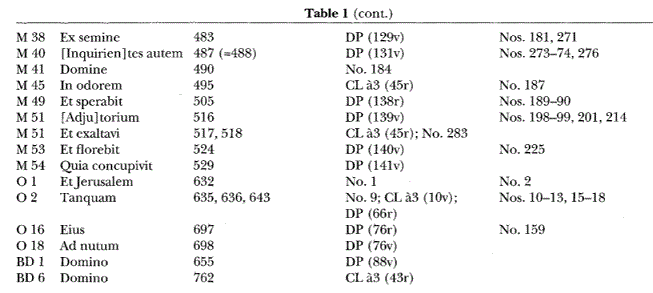 For the purposes of stylistic comparison, I shall focus on clausula features relevant to the texting process: the treatment of modal rhythm, phrase organization in the duplum voice, and cadences in the duplum and tenor voices. Significant stylistic differences between the motet and control groups may indicate which musical features appealed to composers who converted clausulae into motets. 様式的比較のために、私は歌詞づけの過程、モードリズムの扱い、2声のフレーズの機構、duplumとtenorのcadence等についてのクラウズラの特徴に着目したい。モテットグループとコントロールグループ間の重要な様式的相違は、クラウズラをモテットへと転換させた作曲者たちにアピールする音楽的特徴を示すかもしれない。 Since the choice of rhythmic mode in the tenor voice affects modal rhythm and phrasing in the duplum, I will first consider the distribution of clausulae by rhythmic mode in the tenor. As summarized in table 2, the modal distribution varies between different groups of clausulae. Whereas nearly seventy percent of all Notre Dame clausulae are built on unpatterned tenors, the control clausulae are more evenly distributed among modal rhythmic classes. This discrepancy may be attributed to differences in chronology as ascertained from stylistic evidence; whereas unpatterned tenors in ternary or duplex longs dominate the earliest layers of the clausula repertory, later clausulae, including those in the control group, tend to exhibit more advanced stylistic features, including rhythmically patterned tenors and more sophisticated phrasing in the upper voices (Baltzer 1995: xlii-xliv). Differences between the control and motet groups, however, cannot be explained in terms of chronology. These differences indicate that motet composers had a strong preference for clausulae with patterned, fifth-mode tenors, and that they tended to avoid converting clausulae with unpatterned or third-mode tenors into motets. The reasons for these preferences will become more apparent after considering modal rhythm of dupla voices, aspects of phrasing, and cadential patterns. tenorにおけるリズムモード選択はduplumのモーダルリズムとフレージングに影響を与えるので、私は最初にtenorにおけるリズムモードによるクラウズラの配分について考えて見たい。 table2でまとめられているように、モードの配分はクラウズラの異なったグループ同士においては異なっている。すべてのノートルダム楽派のクラウズラ群のうちの約70%はモードパターンではない状態で作られているが、コントロールされたクラウズラ群は、モードリズムの分類の間で、それよりはかなり等しい割合分配されている。 こうした違いは、様式的証拠から確認された時系列の違いに起因するかもしれない。モードパターン化されていないternary or duplex longs を使っているtenorは、クラウズラレパートリーにおいてはもっとも初期の層に属するが、コントロールグループを含んでいる後期のクラウズラは、より発展した様式的特徴、すなわち、リズム的にパターン化されたtenorやより洗練された上声部におけるフレージングを含んでいる傾向がある(Baltzer 1995: xlii-xliv)。 コントロールグループとモテットグループの違いはしかしながら、時系列によっては説明することができない。こうした違いは、モテットの作曲者がパターン化した(第5モードのtenorを持つ)クラウズラに対する強い選好を持ち、パターン化されていないか、第3モードで書かれたクラウズラをモテットに転換させることを避ける傾向にあったことを示している。こうした選好の理由は、2声のリズム、フレーズの観点、そしてcadentialパターンを考慮することで明らかになってくるであろう。 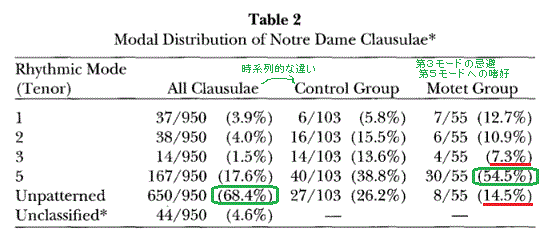 The degree of rhythmic regularity in the duplum voice of a parent clausula has a significant impact on the nature of text declamation in the offspring motet. For purposes of comparison, the extent of rhythmic regularity, or "modal purity," may be expressed as the percentage of ternary-long beats that have a regular modal division as opposed to beats with substitutions in the prevailing rhythmic pattern. For example, in the first rhythmic mode, the strict alternation of longs and breves constitutes "modal purity." "Modal impurity" can result from breaking or "fracturing" the long into two breves, or from extending the long into a ternary long, . which then substitutes for a long-breve combination. Table 3a summarizes the distribution of motet sources and control clausulae by duplum mode and indicates the average levels of modal purity (MP) and impurity from fracturing (FR) or extending (EXT) the modal pattern. Following Apel (1953) and Smith (1990), I will refer to the process of fracturing the long in the modal pattern as fractio modi, and extending the long in the modal pattern as extensio modi.8 親となるクラウズラのduplumにおけるリズムの規則性の程度は、子孫となるモテットにおける歌詞のdeclamationの性質にとっては、重大なインパクトを与えた。比較のために、リズムの規則性の程度、あるいはモードとしての純度が、広く普及しているリズムパターンを代用している拍子とは反対の規則的なモード分割を持つternary-long beatsのパーセンテージで表現されるであろう。 たとえば、第1モードにおいては、厳密なlongaと breveの繰り返しが”モード純度”を作り上げている。”モード純度”は、ternary longに対する,long-breve の組み合わせを代替するfractioとextensioによる中断の度合で決まる(訳注;fractio modiとextentio modiに関しては、Extensio and fractio modiを参照のこと)。 Table 3aは、dupulumのモードにおけるモテット源とコントロールされたクラウズラにおける配分をまとめている。そして、モード純度(MP)の平均レベルとfractio modiあるいはextentio modiの”不純度”を示している。 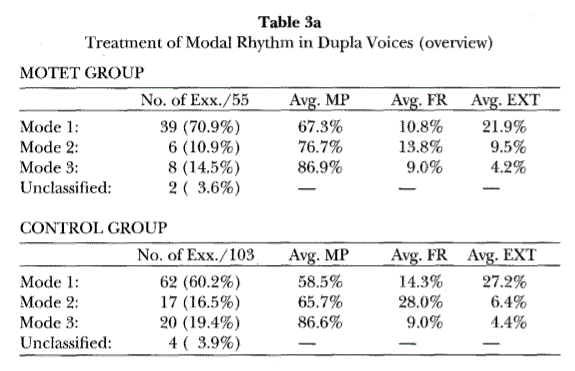 The findings presented in table 3a reveal some interesting differences between the motet and control groups with respect to modal rhythm. In terms of overall distribution, the motet group has a larger proportion of first-mode dupla and a smaller share of dupla in the second and third modes than does the control group. This difference is certainly related to the distribution of tenor modes, for first-mode dupla are often coupled with fifth-mode tenors. However, additional factors may also be at work. table 3aにおいて明らかになることは、モテットグループとコントロールグループの間の、モーダルリズムに関する興味深い相違である。 全体配分でいえば、モテットグループは、コントロールグループよりも、第1モードのduplumにおいて、より大きな割合(proportion)を、第2,3モードのduplumにおいて、より小さな割合(share)を占めている(訳注;両グループはそれほど変わりがあるとは思えないが・・・)。この相違は、確かに、tenorのモードの配分に関係している。なぜなら、第1モードのduplumはたびたび第5モードのtenorとカップリングしているからである。しかしながら、付加された要素もまた、働いているかもしれない。 Focusing on clausulae with first-mode dupla, table 3b shows that the average modal purity level is higher in the motet group than in the control group (67.3 vs. 58.5%). This discrepancy may indicate that composers preferred using clausulae with rhythmic irregularities rather than regular patterning as the basis for thirteenth-century motets. As I will demonstrate, the rhythmic irregularities found in the motet group offered composers greater flexibility with respect to text underlay, and this often resulted in more varied text declamation. As summarized by table 3b, high levels of modal purity are uncommon among first-mode dupla in both groups; only four clausulae in the control group and five in the motet group have consistently regular rhythmic patterning. 第1モードのduplumを持つクラウズラに注目してみると、table 3bは平均的なモード純度レベルがコントロールグループよりもモテットグループにおいて高いことを示している((67.3 vs. 58.5%)訳注;これまたそれほど差があるとは思えないが・・・) こうした不一致は、作曲者が13世紀のモテットのベースとして規則的なパターンよりも不規則なリズムパターンのクラウズラを好んで使ったことを示している。 私が証明したように、モテットグループにおいて見られる不規則性は、歌詞づけに関して、より大きなフレキシビリティを作曲者に与え、そしてこれは歌詞のデクラマシオンにより多くの変化を与える結果になるのである。 table 3bによってまとめられているように、モード純度の高いレベルは、両グループともに、第1モードのdupulumの間では少ない。コントロールグループにおける4つのクラウズラとモテットグループの5つが常に規則的なリズムパターンとなっているのみである。 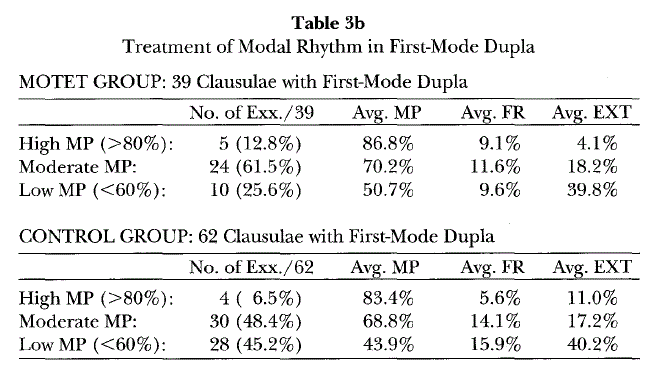 The strictest instance of modal patterning occurs in a Regnat clausula (no. 165) from the motet group, shown below in example 1.9 This paradigm of first-mode rhythm served as the basis for Infidelem populum (motet no. 443). Neither it nor a related Regnat clausula (no. 164), texted as Deus omnium (motet no. 444), experienced long lifespans as motets. They were both converted into two-voice Latin motets but, as far as is known, were never used as the basis for French or double motets.10 Only three other clausulae with high levels of modal purity were transformed into motets. Interestingly, all of them originated as three-voice conductus-motets but also survive in two-voice reductions.11 モードパターンのもっとも厳密な例は、 モテットグループの(この純度の高い4例のうちの1つである)Regnatクラウズラ(example 1)に認められる。この第1モードリズムのパラダイムは、モテットInfidelem populum Haman ad patibulum / Reg (f. 403-403v)のベースとして作用した。 それも、後にDeus, omnium turba gentium / Regと歌詞づけされた関連するRegnatクラウズラも、モテットとしての長いライフスパンを経験していない。それらは両方とも2声のラテン語モテットに転換されたが、しかし、知り得る限り、フランス語や3声モテットのベースとしては決して使われなかった。 モード純度の高い3つの他のクラウズラはモテットへと転換された。興味深いことに、これらのクラウズラ3つすべては、3パートのconductus-motetとして生まれたが、reductされた2声モテットにおいても生き残っている。 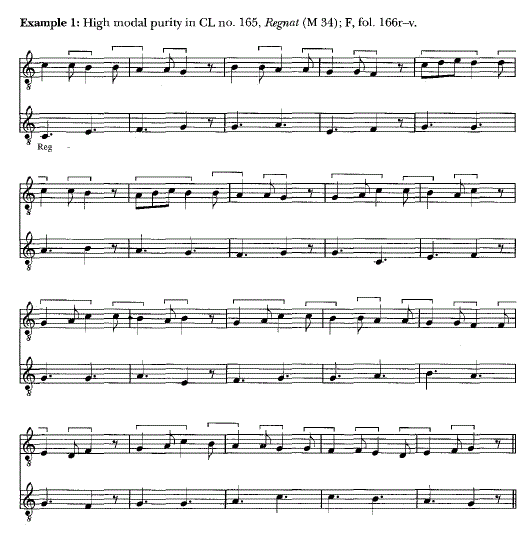 Clearly, selecting clausula sources with high levels of modal purity (coupled with regular phrase lengths) and then underlaying the motet text in a syllabic fashion would have resulted in very regular text declamation, which might have appealed to motet composers who wanted to emulate the poetic regularity of the conductus,12 The composer who underlaid the text Infidelem populum to the modally pure clausula source presented above as example 1 achieved this result. One can readily observe similarities between the texts to this motet and the conductus, Auctor vite, given below as example 2;13 both have regular line lengths and regular accentual patterns at the ends of lines, making them good examples of "rhythmic" poetry (defined by syllable count and final accent, as opposed to "metric" poetry, defined by regular scansion according to patterns of long and short syllables known as "feet"),14 In example 2, both motet and conductus texts feature predominantly seven-syllable lines and regularly recurring proparoxytonic accents on the antepenultimate syllable of each line. This pattern is represented as "7pp." 明らかに、モード純度の高いレベルのクラウズラのソースとしての選択とシラビック形式のモテットの歌詞づけとは、非常に規則的な歌詞のデクラマシオンとなった。そうした非常に規則的な歌詞のデクラマシオンは、conductusの詩的規則性に倣うことを欲したモテットの作曲者にアピールした。12 モードとして純粋な、 example 1のようなクラウズラソースにInfidelem populumの歌詞をつけた作者は、こうした結果を残した。 このモテットInfidelem populum Haman ad patibulum / Reg の歌詞と、example 2で示されたconductusAuctor viteの歌詞との間の類似性を見ることができる。両方とも規則的な行の長さと、そして最後の行における規則的なアクセントパターンを持っている。それぞれリズム的詩の良い例を作りながら。14 example 2においては、モテットとconductusの歌詞は、主に、7音節の行と、それぞれの行のantepenultimateな音節における規則的なrecurring proparoxytonic accentとして特徴づけられる。このパターンは7ppとして表される。 example2
Another way to achieve regular patterning would have been to underlay text in a neumatic fashion to music with high levels of fractio modi. However, as discussed below, this approach was much more typical of French motets than of early Latin ones. With respect to the early Latin motet, it appears that after some initial experimentation, composers came to prefer using clausula sources with greater rhythmic contrasts. This shift in preference marks an important step in the emergence of the Latin motet as a genre characterized by irregularities of design and therefore distinct from the more patterned style of the conductus. 規則的パターンの遂行のもう一つの方法は、ハイレベルなfractio modiの音楽に対するネウマ譜の流れにそって歌詞づけをすることである。前述のように、このアプローチはより以前のラテン語モテットよりもフランス語モテットにおいてより典型的であった。初期のラテン語モテットに敬意を払い、いくつかの研究後、作曲者たちはより大きなリズム的コントラストがあるクラウズラソースを好んでつかうようになったことが明らかになっている。これは、デザインの不規則性をその特徴とするラテン語モテットの出現において、重要な一歩を踏み出したことになるのである。そしてそれゆえ、conductusのより規則的なパターンからは離れていくことになる。 As shown in table 3b, both the control and motet groups have a large portion of clausulae with moderate levels of modal purity, ranging from sixty to eighty percent. Although the twenty-four motet sources in this moderate range have slightly higher levels of modal purity than the thirty "moderate" control clausulae (70.2 vs. 68.8% on average), the "moderate" motet sources still feature more instances of extensio modi than the control clausulae (18.2 vs. 17.2%). A passage from clausula no. 101, shown below as example 3, typifies the style of the "moderate" motet sources.15 As I will illustrate, the shifting rhythmic patterns made it possible for composers to underlay text in order to underscore units of text through contrasting rates of text declamation. table 3bに示されているように、コントロールグループにおいてもモテットグループにおいても、適度なモード純度レベルを持つクラウズラが、60〜80%におよぶ大きな割合を占めている。24のモテットソースは適度な範囲において、30の”適度”なコントロールグループのクラウズラより若干高いレベルのモード純度を保っているが、”適度”なモテットソースは、コントロールグループのクラウズラよりさらにより多くのextensio modiを持つことを特徴としている(訳注;これまた、18.2%対17.2%でほとんど変わらないが)。クラウズラNo.101におけるパッセージは、”適度な”モテットソースの様式の典型である。 すでに述べたように、シフトしたリズムパターンは、作曲者が、歌詞のデクラマシオンのコントラスト比を通じて歌詞単位を強調するために歌詞づけすることを可能にしたのである。 Differences between the motet and control groups are even more striking when one considers the substantial number of clausulae from both groups with low levels of modal purity. Of the twenty-eight control clausulae with low levels of modal purity, there are nineteen pieces in which extensio modi constitutes the principal component of modal impurity. In the motet group, eight of ten pieces with low modal purity feature significant amounts of extensio modi. The effect in such compositions is that the duplum voice moves in a mixture of first- and fifth-mode rhythms. Whereas clausulae in the motet group tend to alternate between longer passages of first-mode and ternary-long rhythms that allow for contrasting rates of text declamation, ten of the control clausulae with high levels of extensio modi have significant numbers of single ternary longs followed by ternary-long rests. Individual ternary longs followed by rests would have presented difficulties for text underlay because they would have disrupted the semantic flow with their hocket-like effect; thus, composers generally avoided converting clausulae with isolated ternary longs into motets. Alpha bovi et leoni (762) represents one notable exception. As shown in example 4, the composer of this motet underlaid isolated ternary longs present in the clausula source with the monosyllabic exclamation "0," which also reinforces the vowel sustained by the "[Benedicamus] DO-mino" tenor. モテットグループとコントロールグループの間の相違は、両グループのうちでモード純度が低いレベルのクラウズラの実質的な数を考慮すると、より顕著なこととなる。 28のモード純度の低いコントロールグループのクラウズラのうちで、19作品はextensio modiがモード純度のおもな構成要件となっている。モテットグループのうちで、モード純度の低い10作品のうち8つはextensio modiが重要な要素を占めている。 こうした作曲上の効果は、duplum声部が第1、第5モードリズムの混合の中で動き回ることにある。モテットグループのクラウズラは、歌詞のデクラマシオンを対比するように第1モードとternary-long rhythm間のより長いパッセージの間を行き来しているが、 高いレベルのextensio modi を持つコントロールグループのクラウズラのうちの10ケには、ternary-long休符を伴なったかなりな数の単一のternary longを認める。 休符を伴った個々の ternary longは、歌詞づけには困難を伴っていた。なぜなら、それらはhocketのような効果により、構文上の流れが邪魔されるからであった。それゆえに作曲者たちは、一般的に、孤立したternary longを伴うクラウズラをモテットに転換することは避けていた。 Alpha bovi et leoniはひとつの注目すべき例外を示している。 example 4で示されているように、このモテットの作者は、単一音節のexclamation"O"でもって、クラウズラソースにある孤立したternary longを歌詞づけした。"O"は"[Benedicamus] DO-mino" tenorによって支えられた母音を強調するのである。 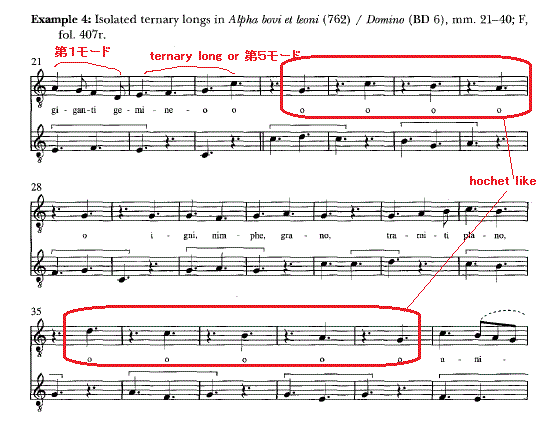 The control group also includes seven c1ausulae with exceptionally high levels of fractio modi. Example 5, a passage from clausula no. 12, illustrates this approach. This Tanquam c1ausula, from the Christmas Responsory Descendit de celis (0 2), has fractured rhythms on seventy percent of its beats. Substantial amounts of fractio modi would have presented difficulties for the predominantly syllabic approach to text underlay characteristic of the early Latin motet. Thus, the motet group has consistently lower levels of fractio modi on average, and has no member with more than 37.5% of its beats fractured. Apparently, composers only avoided high levels of fractio modi when converting clausulae into early Latin motets, in which the predominant method of text underlay was syllabic; clausula sources for French motets often have significant amounts of fractio modi. I have argued elsewhere that composers of both clausula‐based and newly composed French motets tended to underlay their texts in a more neumatic fashion in order to achieve greater regularity in text declamation (Kidwell 1996). コントロールグループはまた、例外的にfractio modiを多く含む7つのクラウズラを含んでいる。Example 5はこのアプローチを説明する。 このTanquamクラウズラはChristmas Responsoryである Descendit de celis であるが、その拍子において70%がfractured rhythmである。fractio modiの数のその多さは、早期ラテン語モテットのキャラに歌詞づけするための支配的なシラビックなアプローチを困難にすることだろう。それゆえ、モテットグループはだいたい、低いアベレージのfractio modi を保っているのである。 明らかに作曲者たちは、クラウズラを(優勢な歌詞づけの方法がシラビックであった)初期ラテン語モテットへ転換するにおいては、高いレベルのfractio modiを避けていた。つまり、フランス語モテットのためのクラウズラソースは、しばしば、かなりな数のfracitio modiを保有していたのである。 私は、クラウズラをベースとしたフランス語モテットと新たに作曲されたフランス語モテットの両方の作曲者が、歌詞デクラマシオンにおいてより大きな規則性を成し遂げるために、よりネウマ譜的傾向において歌詞づけする傾向にあることを別の箇所で論じた。 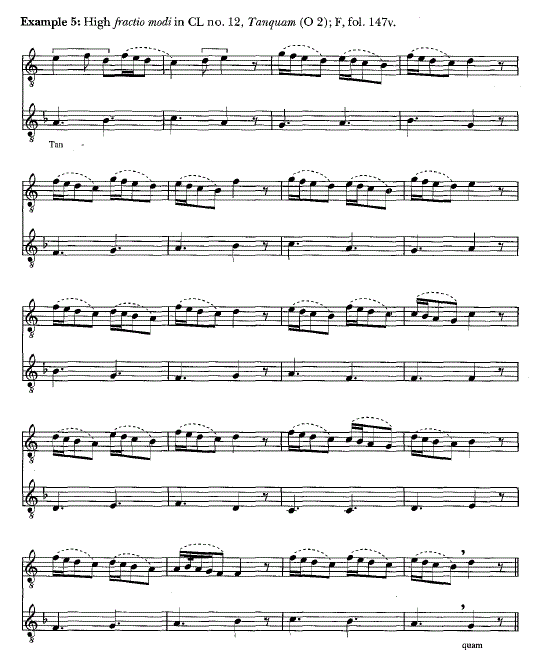 Some of the observations about clausulae with first-mode dupla shed light on the use of clausulae with second- and third-mode dupla as sources for early Latin motets. In general, second-mode clausulae often have significant amounts of fractio modi while third-mode clausulae tend to be modally pure. Since composers avoided selecting first-mode clausulae with heavily fractured modal rhythms or with high levels of modal purity, it comes as no surprise that they used only a limited number of second- and third-mode clausulae as models for early Latin motets. 第1モードのduplumを持つクラウズラについての考察は、初期ラテン語モテットのソースとしての第2、第3モードのduplumを持つクラウズラの利用についての道を開く。 一般的に、第3モードのクラウズラがモード的に純粋である傾向に対し、第2モードのクラウズラは、かなりの数のfractio modi を保有しているものである。作曲者らは、より多くのfracture化したモードリズムを持つ第1モードクラウズラ、あるいは高いレベルのモード純度を持つ第1モードクラウズラを選ぶことを避けていたので、彼らが限られた数の第2,第3モードクラウズラを初期のラテン語モテットのモデルとして使うようになったことは、驚くべきことではない。 Clausulae with second-mode dupla made up 16.5% of the control group but only 10.9% of the motet group (table 3a). On average, the second-mode clausulae in the motet group have higher levels of modal purity than those in the control group (76.7% vs. 65.7%) due to considerably lower levels of fractio modi (13.8% vs. 28.0%). It also seems significant that none of the clausulae in the motet group has fractured rhythms on more than 18.5% of their beats. This once again supports the hypothesis that composers of early Latin motets found high levels of fractio modi problematic for texting because of their preference for syllabic text underlay. Conversely, high levels of fractio modi did not deter composers from converting heavily fractured clausulae in the second rhythmic mode into French motets any more than it hindered them from selecting heavily fractured clausulae in the first mode as French motet sources. 第2モードのduplumを持つクラウズラはコントロールグループのうちの16.5%であり、モテットグループのうちのわずか10.9%であった(table 3a)。平均では、モテットグループの第2モードのクラウズラは、コントロールグループより高いモード純度を持っている(76.7% vs. 65.7%)。それは、一貫して、モテットグループのfractio modiの割合が低いためである(13.8% vs. 28.0%)。 モテットグループのクラウズラのどれもが、fractureされたリズムを18.5%以上持っていないことは、注目すべきことである。これは、初期のラテン語モテットの作者がシラビックな歌詞づけを好んだために、歌詞づけのためのfractio modi の問題点を高いレベルで見出していたという仮説を再度支持することになる。 逆に、高いレベルのfractio modiは、作者をして、多くのfracture化された第2モードリズムのクラウズラを、それがフランス語モテット源としての第1モードでありかつ強くfractureされたクラウズラを選択することを妨げること以上に、フランス語モテットへと転換せしめることを禁じせしめるのである。  |